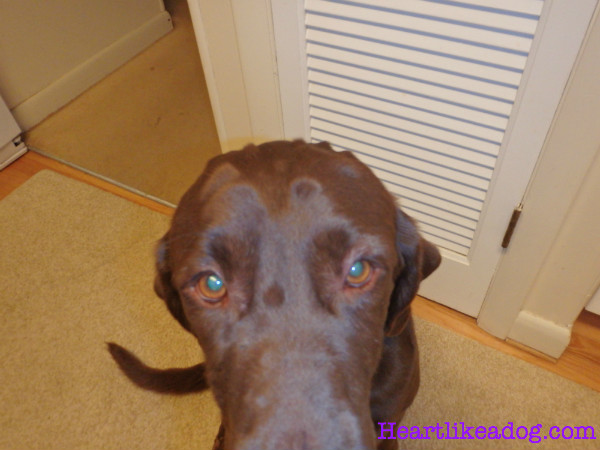It seems like for the past two years, every time one of my dogs goes to the vet with a symptom, Cushing’s Disease comes out of my vet’s mouth.
Some of you may recall Sampson had a urine test about 18 months ago, because the vet suspected…Cushing’s.
When Delilah’s Urinary Tract Infections started back in December, Cushing’s was once again brought up. Since I’d already researched Cushing’s symptoms, I was adamant, “She does not have Cushing’s.”
What is Cushing’s Disease?
In a nutshell, Cushing’s Disease is an over-production of a hormone called “cortisol.” Cortisol is a hormone produced in the Adrenal Glands (two little walnut-sized glands that rest on top of the kidneys.) These little glands are the guys that produce that “fight or flight” response when you feel threatened. They are also the little guys that give moms that super human strength to lift a car off their child. (If you want to read up on Cushing s, you can check it out HERE.) Cushing’s can result from a tumor on the Adrenal Glands, but it can also be an Endocrine-active tumor on the Pituitary Gland, which is a pea-sized gland at the base of the brain. The Pituitary Gland (as I understand it) tells the Adrenal Glands, “Get cracking, it’s time to make the Cortisol. (Similar to the guy at Dunkin Donuts, who says, it’s time to make the donuts. For the record though, donuts are far more enjoyable than a tumor.)
When a body is producing too much Cortisol, you can imagine what kind of havoc it can wreak, and how having too much Cortisol in your body can be a very bad thing.
What are the symptoms for Cushing’s?
According to PetMD, the symptoms for Cushing’s are as follows:
- Increased thirst and urination
- Increased hunger
- Increased panting
- Pot-bellied abdomen
- Obesity
- Fat pads on the neck and shoulders
- Recurrent infections of skin, ears, urinary tract, etc.
- Loss of hair
- Lack of energy
- Inability to sleep (insomnia)
- Muscle weakness
- Infertility
- Darkening of the skin
- Appearance of blackheads on the skin
- Thin skin
- Bruising
- Hard white scaly patches on the skin, elbows, etc. (associated with the disease calcinosis cutis)
- Neurologic abnormalities (circling, behavioral changes, seizures, etc.) Source
Of the symptoms listed above, there were only two that Delilah exhibited. The first was the bout she had with UTI’s that started in December and ran through the middle of April.
The other, is her unquenchable third. Delilah drinks an enormous amount of water. In fact, if you filled her bowl with a gallon of water, she would drink it all.
A good portion of the time, her drinking is around meal times, or just before or after her walks.
Shortly after Delilah came to her forever home, I took her into the vet to question her massive water consumption. At that time, I suspected she had Diabetes, but that was ruled out with a blood test. We did discover however, that her Thyroid levels were low. We put her on Levoxythyrine and she’s done quite okay with it.
Hubby and I theorize that Delilah’s water consumption is a learned behavior. Our theory is Delilah has learned that water helps fill her up. We believe it stems from the time she spent on her own, on the Mean Streets of Lake Charles, but that is only a guess.
To help Delilah with her water intake, we moderate the amount of water that is put into her bowl at all times; because the water bowl is like the Field of Dreams…if you fill it, she will come. And drink it all.
It sucks for poor Sampson, but we are always at the ready to jump up and give him water when he indicates he requires some.
As I stated earlier, this ‘argument’ if you will, with my vet has been ongoing for some time now. In my vet’s defense, Cushing’s is very common in older dogs, and it is probably one of the easiest diseases to test for.
After Delilah finished the herbs prescribed by the Holistic Vet, we had her urine checked. When our vet called, she said there was no infection, but Delilah’s urine was more diluted that she’d like. When I asked what might cause that, she said “Cushing s.”
I’d finally had enough, “Maybe we should just have her tested so I can stop having this conversation,” I said to Hubby.
How is Cushing’s Disease diagnosed?
To test for Cushing’s plan to have your dog stay at the Vet’s office for the day. There are a number of different tests your Vet can use, but mine used Low Dose Dexamethasone Suppression (LDDS.) This is the most accurate test to diagnosis Adrenal Cushing’s. Your dog is given a shot of Dexamethasone which is a synthetic cortisol, which should stop the body’s production of Cortisol. (Source) The Vet then draws blood at various intervals. The Cortisol levels in dogs WITHOUT Cushing’s disease will decrease over time. However, if your dog HAS Cushing’s disease the levels will remain the same, or in some instances increase.(If the Adrenals and Pituitary are healthy, the gland knows there is enough Cortisol in the body, if they aren’t doing their job, the Adrenals will continue to produce Cortisol.)
There is some controversy/confusion over fasting with this test, which is one of the biggest reasons I hesitated to put Delilah through the test. Initially, my Vet said Delilah had to fast. Now this may seem silly to some, but I promised Delilah a long time ago, that as long as I had control over it, she would never miss a meal again. Then I was chatting with my friend, she said her dog only had to fast for the first draw. Then they fed him his breakfast. So I questioned my Vet’s office and was told, “Yes, fasting is required.” Hubby and I talked, and for the sake of putting the Cushing’s diagnosis to bed, we decided to go ahead with it.
Flash forward to the day before the test, and my Vet’s Office called to confirm, and said, “No fasting required.”
I asked her if she were sure, and she said she’d check, but if I didn’t hear from her, to fast Delilah.
I called on my way home to see what the cutoff time was for food and water, and was again told, no fasting required.
I asked her to confirm with my vet, and she put me on hold, then told me again, “No fasting required. We want Delilah to be happy and comfortable.” (As comfortable as she can be stuck in a crate with people poking her with needles all day long.) “Delilah will be happiest if she’s had breakfast,” I assured her.
The next morning Delilah got her breakfast, and Hubby dropped her off at the Vet’s office, and picked her up when it was over.
Delilah Does NOT have Cushing’s Disease (a.k.a. I TOLD YOU SO, I TOLD YOU SO, I TOLD YOU SO!)
The next night my Vet called with the results of Delilah’s test. “As you suspected, Delilah does not have Cushing’s Disease” my vet said. I turned and looked at Hubby with that smug look I save for when I’m being totally vindicated (yes, apparently I am making this about me,) and I think I actually did a fist pump or thumbs up too. I couldn’t actually say, “I told you so,” to my Vet, nor could I tell her that I’m done having this conversation, but I did tell her I was glad we had ruled it out, because I knew she was concerned about it. She did go on to say that just because Delilah doesn’t have Cushing’s now, doesn’t mean she can’t get it in the future. She is concerned because Delilah’s urine is diluted and she can’t seem to concentrate it.
I explained Hubby and my theory and she said typically dogs that drink a lot have an underlying issue, she didn’t rule out a behavioral issue, but she said those are pretty rare. She also suggested adding a bit of water to Delilah’s food, to see if that makes a difference.
The discussion then became, how far do we want to dig to get to the bottom of the UTI’s and the diluted urine; and the answer is, this is far enough. If the situation changes down the road, we will cross that bridge when/if we need to.
If it’s NOT Cushing’s Disease, what could it be?
The next day I did the Google to see what could make a dog not concentrate her urine, and found there are a number of other diseases/afflictions/conditions which could be causing this. Chemical Imbalance of the Urine (Source), Water Diabetes (Source) are two of the illnesses I found. Since both of them require additional testing, we will not pursue a diagnosis at this time.
Are some breeds more susceptible to Cushing’s Disease than others?
The answer is yes! Some dog breeds like Labradors, Beagles, Poodles, Terriers, Dachshunds and German Shepherds are more susceptible to Cushing’s Disease than others. The disease also tends to strike middle-aged to senior dogs.
Are there different tests that diagnose Cushing’s Disease?
Yes. There is a urine test that costs around $100, and last I knew, there was only one laboratory in the US that ran the test, and that is in Wisconsin. The test will NOT tell you if your dog HAS Cushing’s disease, but it can tell you that your dog DOES NOT have Cushing’s disease.
If you are concerned about leaving your dog at the Vet’s all day, or about the cost for the Cushing’s test (Delilah’s test was $246), then you may want to speak with your Vet about the urine test that can rule out the disease.
I chose to go with the actual LDDS test because of Delilah’s urine dilution issue.
Disclaimer: I am not a Veterinarian, I don’t play one on TV, and I haven’t stayed at a Holiday Inn Express lately. What I have shared here is my experience and understanding of Cushing’s Disease in Dogs. It is not meant to be used as a diagnostic tool. If you have concerns that your dog might have Cushing’s Disease, please consult your own Veterinarian.










Recent Comments